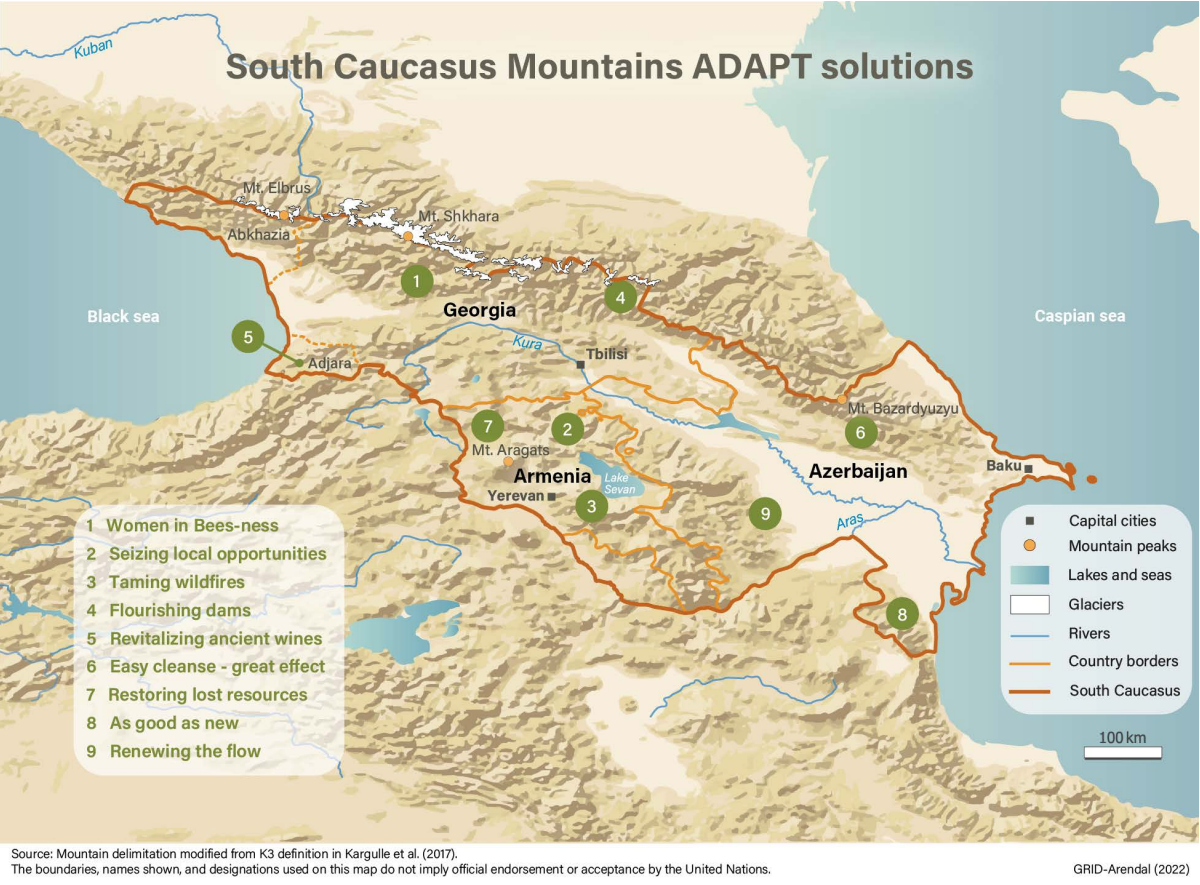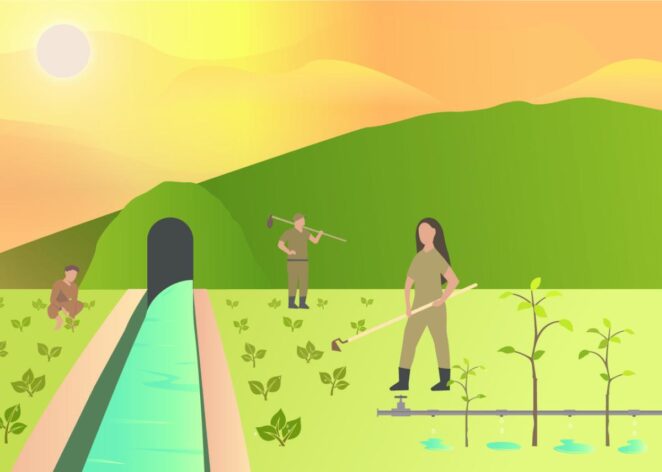Mountains ADAPT: Solutions from the South Caucasus

This publication is an output of the global programme Adaptation at Altitude: Taking Action in the Mountains, funded by the Swiss Agency for Development and Cooperation (SDC).
The solutions included in this publication can also be found on the Adaptation at Altitude Solutions Portal.
Introduction
The Mountains ADAPT: Solutions from the South Caucasus booklet showcases adaptation solutions proven to be successful in response to specific issues caused, or accelerated by, climate change that negatively affect mountain communities’ livelihoods and ecosystems. These solutions were selected for their inclusive approaches, their potential to be transferred and upscaled, as well as their extended benefits to downstream communities across the region.
The booklet aims to highlight a variety of possible approaches in addressing climate change related vulnerabilities. The booklet focuses on actions and measures that already have been or are being implemented to allow for evaluation of their impacts. Enabling factors are also assessed to show the potential for replication in different sociocultural, ecological, political, or economic contexts, sectors, and geographies.
The objective of the publication is to share knowledge with local, regional, and national policymakers, practitioners, potential donors as well as local communities and the interested public about mountain adaptation solutions. The collection aims to inspire, facilitate, and promote the uptake, transferal, and upscaling of adaptation action in the mountains of the South Caucasus.
This booklet zooms in on concrete adaptation solutions in the mountains and communities of the South Caucasus region, located between the Caspian Sea and the Black Sea. It covers the three countries of Armenia, Azerbaijan, and Georgia. The region has a diverse climate, in large parts because of its altitudinal differences and complex terrain: the biomes found at altitudes include alpine meadows in the North and steppe landscapes in the drier mountain plateaus of the South (Muccione and Fiddes 2019; Zazanashvili et al. 2020). The mountainous parts of the three countries are inhabited by a rural population that is mainly working in the countries’ agricultural sectors.
Authors: The booklet was written by Sabine McCallum, Ansgar Fellendorf (UNEP), Torjus Solheim Eckhoff, Laurent Fouinat (GRID-Arendal), Sophiko Lomineishvili (Caucasus Network for Sustainable Development of Mountain Regions – Sustainable Caucasus) together with Ashot Sargsyan (Consultant in Armenia) and Aytan Poladova (Consultant in Azerbaijan).
*This weADAPT article/case study is an abridged version of the original text by GRID-Arendal and partners, which can be downloaded from the right-hand column. Please access the original text for details of the solutions, and for research purposes, full references, or to quote text.

About the solutions
In this booklet, adaptation solutions are defined as planned or autonomous responses that address one or several mountain-specific challenge(s) and exploit opportunities to adapt to changing future environments. Thus, they represent mountain-specific interventions that build socioecological resilience, strengthen adaptive capacity, and contribute to climate-resilient development pathways. As such, the solutions benefit people’s livelihoods and income opportunities, and further support healthy mountain ecosystems.
The 9 solutions in the booklet have been implemented or are being implemented at the time of writing in three countries of the South Caucasus. These solutions are designed to bring multiple benefits, such as improved local resilience and biodiversity, and a better life with more income opportunities for the people in the communities in which they are implemented. The description for each solution answers the following key questions:
- What is the issue?
- How can it be solved?
- Who is benefitting?
- How could it work elsewhere?
The solutions are organised into four categories:
- Diversified livelihoods with climate and biodiversity benefits
- Disaster risk reduction
- Erosion control
- Water harvesting and retention
The solutions focus on essential aspects of adaptation in mountain areas, and attention is paid to implementation strategies, financial schemes, local voices, gender equality and success factors such as ownership and co-creation of the local communities. Although all solutions are context and site specific, they share certain enabling factors for successful implementation, i.e., local community support, economic and other co-benefits, as well as incorporating traditional knowledge and socioeconomic practices.
Most of the solutions showcased are associated with development projects, with a variety of solution providers highlighted. Some can be considered bottom-up, whereby local actors initiated action, while others stem from donor-driven projects initiated by national, regional, or international actors.
Selection of the solutions
Adaptation solutions were gathered and selected following a step-by-step process along six key dimensions to qualify for a mountain adaptation solution:
- relevance in addressing at least one mountain specific climate change risk.
- practicality and feasibility of implementation in terms of human and financial resources available.
- direct benefits and co-benefits to the environment, the economy, and society, especially with regards to gender equality and empowering women and girls.
- flexibility and robustness in terms of effectiveness under a range of different climatic and socioeconomic development scenarios.
- potential for adjustment, replication, or upscaling in other geographic, social, or sectoral contexts.
- political, cultural, and social acceptability and coherence with existing or planned policies at the local, regional, and national level.
The selected adaptation solutions portray cases and inspiration for achieving the United Nations 2030 Agenda for Sustainable Development and its 17 goals, especially Sustainable Development Goal (SDG) 5 on gender quality, SDG 6 on clean water and sanitation, SDG 13 on climate action, SDG 15 for life on land and SDG 17 on partnerships for the goals. Similarly to the SDGs, the solutions view different aspects of sustainable development and adaptation comprehensively, interconnected, and partly dependent on each other.

Context: the South Caucasus
In each country in the South Caucasus, the concentration of economic activity and development has been led by capital cities leading to patterns of spatial disparities between urban and rural areas. Access to income generating opportunities is generally low among the geographically more isolated, perpetuating the dependence on low-productivity agriculture (The World Bank Group 2019). The communities have less access to education and healthcare than in the cities and are closely interlinked with and depend on their surrounding natural environment. This makes the mountain inhabitants of the South Caucasus particularly vulnerable to the effects of climate change, which is already altering the fundaments of their livelihoods.
Climate change and socioeconomic challenges
The climate in the South Caucasus region is expected, with some local uncertainties, to become warmer and drier with less predictable rainfall patterns, along with an increase in extreme precipitation events. Warmer temperatures are likely to alter water cycles and reduce water availability in the mountains, as well as downstream (Shatberashvili et al. 2015; Muccione and Fiddes 2019). Mountain farmers and herders will therefore have to adapt to drier conditions, while forest management will need to be prepared for a heightened risk of fires or other forest disturbances, such as drought, disease outbreaks, decrease in reproducing potential and thus protective functions. Heavy rainfall events are forecasted to occur more frequently by 2050, which for mountain communities means a higher risk of landslides and increased erosion (Shatberashvili et al. 2015; Bayramov et al. 2019). A combination of poor management and inadequate land use practices are putting local environments under heavy pressure. Climate change and its effects are often an additional trigger exacerbating already existing challenges.
In the 20th century, Armenia, Azerbaijan, and Georgia formed part of the Soviet Union. Since its collapse, the countries have experienced multiple reforms in the context of complex social and political structures. The economy has improved since the crises in the 1990s, but cluttered agricultural reforms and changing water management institutions have limited the rural mountain communities’ adaptive capacity (Shatberashvili et al. 2015; Worden and de Beurs 2020).
See the full text for references.
Suggested citation
United Nations Environment Programme and GRID-Arendal (2022). Mountains ADAPT: Solutions from the South Caucasus. Nairobi: United Nations Environment Programme.
Contributors
In-depth information about mountain adaptation solutions has been provided through highly valued contributions from (listed after numbering of solutions in this booklet):
- (1) Nino Elizbarashvili (GAWB, Georgia)
- (2) Rubik Shahazizyan (Ministry of Environment of the Republic of Armenia, Armenia)
- (3) Armen Chilingaryan (UNDP, Armenia)
- (4) Natia Kobakhidze (GIZ, Georgia)
- (5) Rezo Getiashvili (CENN, Georgia)
- (6) Samir Abbasov (GIZ, Georgia)
- (7) Lusine Kocharyan (Armenian Red Cross Society, Armenia)
- (8) Jabir Alizada (EWMI, Georgia)
- (9) Ilgar Khudiyev (IOM, Azerbaijan)
Layout: GRID-Arendal
Illustrations: Hasan Abbas, GRID-Arendal
Acknowledgements
The authors thank Björn Alfthan (GRID-Arendal), Matthias Jurek (United Nations Environment Programme) and Nina Shatberashvili (Sustainable Caucasus) for general guidance and feedback; Magda Biesiada, Mark Grassi, Janet Macharia, Susan Mutebi-Richards, Jane Muriithi, and Annette Leopold (all United Nations Environment Programme) for reviewing elements or the whole publication.
Related reading
- UNEP news story "Mountain adaptation solutions: turning challenges into opportunities" (April 2022)
- Adaptation at Altitude Regional Meeting: Taking Action Together for Resilient Mountain Communities in the South Caucasus
- Inter- and transdisciplinary mountain data in the Caucasus: Identifying user requirements and access preferences
- Mountains ADAPT: Solutions from East Africa
- Mountain Adaptation Outlook Series: Synthesis Report
- Mountain Adaptation Outlook Series: Outlook on Climate Change Adaptation in the South Caucasus Mountains (2015)

Comments
There is no content